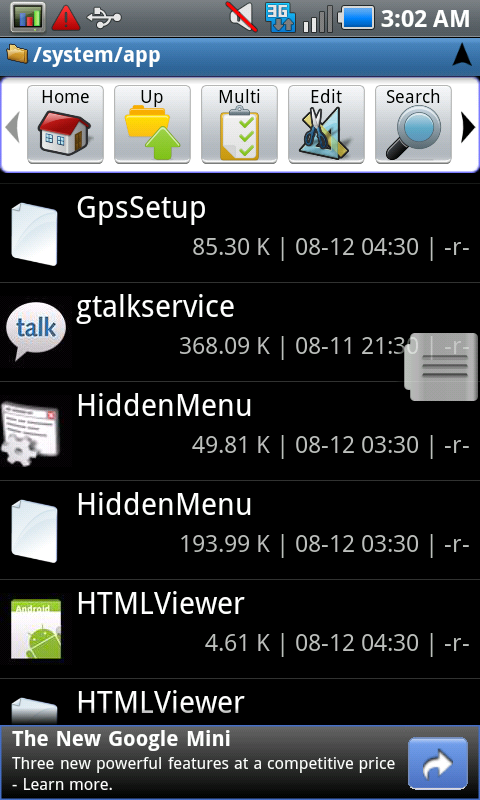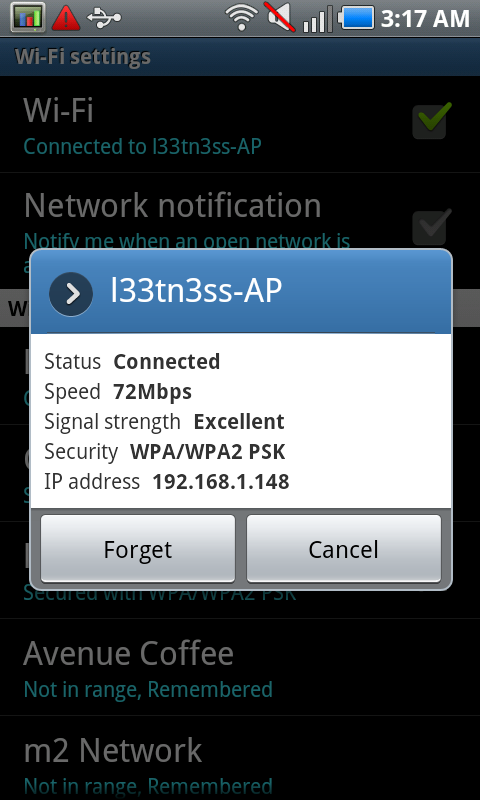Samsung Fascinate Review: Verizon's Galaxy S Smartphone
by Brian Klug on October 5, 2010 12:01 AM EST- Posted in
- Smartphones
- Samsung
- Galaxy S
- Fascinate
- Mobile
Cellular and WiFI Performance
The Fascinate doesn't have any antenna problems or weird baseband quirks. I experienced stable data connections and calls. We still run the phone through our now-regular tests to determine attenuation from holding devices in different positions.
| Signal Attenuation Comparison in dB—Lower is Better | |||||||
| Cupping Tightly | Holding Naturally | On an Open Palm | |||||
| Samsung Fascinate | 10.0 | 5.0 | 0.0 | ||||
| Droid 2 | 11.5 | 5.1 | 4.5 | ||||
| BlackBerry Torch | 15.9 | 7.1 | 3.7 | ||||
| Dell Streak | 14.0 | 8.7 | 4.0 | ||||
| Droid X | 15.0 | 5.1 | 4.5 | ||||
| iPhone 4 | 24.6 | 19.8 | 9.2 | ||||
| iPhone 3GS | 14.3 | 1.9 | 0.2 | ||||
| HTC Nexus One | 17.7 | 10.7 | 6.7 | ||||
The Fascinate (like the Epic 4G) seems to only expose signal changes in 5 dBm steps. Like Anand in the Epic review, I measure exactly the same thing. It's a bit frustrating to measure, but I managed to do so on the Fascinate after taking a lot of data - it didn't change. Unsurprisingly, attenuation is completely in line with what we've seen for other typical smartphones, sans iPhone 4. It's a bit frustrating that the radio stack doesn't show more granularity like other Android devices I've played with (all of them to date have showed me signal in 1 dBm steps), so I was determined to find more.
Just about every phone has special dialer codes. They're usually prefixed with "##" or asterisks, and just about every Android device has the somewhat famous "*#*#4636#*#*" special menu for doing basic things. The Captivate and Vibrant have gotten quite a bit of attention for having extremely thorough secret dialer codes, something I seriously favor in any device.
Regardless, I set out to discover whether any internal dialer codes could reveal more hardware information than I was seeing in Android through the UI and normal APIs.
To do so, I searched through the .apk files inside /system/app. Android package files are essentially zip files with a number of other files for the Android platform inside, including AndroidManifest.xml. Unfortunately, that XML file is encoded in binary, and requires some special unpacking. Regardless, I searched through and found lots of tasty goodness inside the ever so auspiciously-named hiddenmenu.apk file.

I found what I think are the Fascinate's internal codes, but none of the dialer prefixes I can think of work. Searching through everything in the Samsung GPL code repository for SCH-i500 (the Fascinate's model name) thoroughly revealed nothing either. The Samsung GPL code repository is here, just search SCH-i500 and you'll get the whole thing. It's possible that I missed the dialer code prefixes in there, but at the end of the day I couldn't find them. I also manually tried everything I could think of.
If you're so inclined, that AndroidManifest.xml file is up on pastebin here. There's a few interesting things inside. At the end of the day, however, I couldn't make anything work.
Update:
With the help of a friend with access to more information than I ;), I was able to finally figure out how to enable secret codes on the Fascinate. It's one of the most complicated procedures I've seen on a phone to date, but not impossible:
In the dialer, enter *#83786633 and tap the home button. Now, go back into the dialer, clear anything still in the dialer completely (the first code should still be there), and enter *#22745927. You'll be prompted for an SPC code, which should be 000000. Now you should get dumped to a screen like this:

Toggle enable, hit ok, and then things should work. This is the hiddenmenuenable apk I spent forever trying to get to. The dialing prefix is then *# with a suffix of # which is just like the other Galaxy S phones I've seen. Even then, the dialer codes are somewhat obfuscated - the only one I've found so far is #*4636*1111# which brings up the testing menu standard to other Android devices. I'm sure there are more out there.

Finally, I ran well over 100 speedtests on the Fascinate using the SpeedTest.net application, and averaged a downstream speed of 0.888 megabits/s, and upstream speed of 0.673 megabits/s. That's roughly in line with performance around town, with spikes up to 1.8 megabits/s of downstream near a tower.
WiFi Performance
The Fascinate negotiates a 72 megabit/s link with my 802.11N network - faster than the 65 megabits/s I've seen which is the bare minimum required to meet 802.11N requirements.

Wireless range on the Fascinate isn't quite as far as the EVO 4G or iPhone 4. I can make it a few more meters to the curb before falling off my AP on other devices. That said, the WiFi performance itself is not bad - 20 megabits/s on my 802.11n network downloading a 100 MB PDF.

There's also tethering support on the Fascinate, however the device I had time with wasn't provisioned for access and I couldn't test it. I could however get to the provisioning portal Verizon has, and that worked fine, but I couldn't tell if there were any hotspot issues like the Droid 2 had.










73 Comments
View All Comments
Ethaniel - Tuesday, October 5, 2010 - link
Good thing you directly recommend rooting and flashing the device. That Verizon-pseudo Google-Bing combo is kinda creepy... and bloated.medi01 - Tuesday, October 5, 2010 - link
"Outside readability in practice is improved from the Nexus One. "Dare I ask whether it is improved from, God forbid, iPhone 4? :rolleyes:
deputc26 - Tuesday, October 5, 2010 - link
In the performance page,Loading Engadget Times
EVO Should be 2.2 not 2.1.
Brian Klug - Tuesday, October 5, 2010 - link
I haven't included numbers from the EVO running 2.2 yet, although I've got them and will do so, those are current for 2.1 (as marked) ;)-Brian
Shlong - Tuesday, October 5, 2010 - link
it seems the Epic with Sprint is the best out of the Galaxy S line.alovell83 - Tuesday, October 5, 2010 - link
The Korean Galaxy S would beg to differ. FF cam + DMB. Yes, you do lose out on 4G, but you save hundreds on the life of the contract and it isn't as much up front either. Out of those available to the U.S. it's the $10 4G tax, without necessarily receiving a 4G signal which is the bummer, but you still get the best kit subsidized state-side. Living in a 4G city, the Epic is a no-brainer. Outside, we are talking about $300 more, assuming you don't get an amazon $.01 deal which would bump the contract life of the Epic to more than $400 more than the others...just for a FF camera and (cross you fingers, hopefully) to one day get a 4G signal in your city is just asking for too much.silverblue - Tuesday, October 5, 2010 - link
I have the UK version of the Galaxy S, and it's quite odd how many variants are out there. Differences on the UK version:1) no LED flash
2) sports an FF cam
3) the micro-SD slot is on the left inside the back, with the SIM card to the right and the built-in micro-SD above that
4) the buttons are confined to Menu on the left, Back on the right, and a physical Home key in the middle
5) the headphone socket has a black plastic surround instead of chrome effect (strangely, the review states 18mm - shouldn't that be 35mm?)
6) there's a "with Google™" logo on the back along with the SAMSUNG logo but no mention of Galaxy S; there's no mention of the carrier.
7) the phone weighs less at 118g
8) The default wallpaper isn't a Live one
deputc26 - Tuesday, October 5, 2010 - link
Interesting and yes that should be 35mmBrian Klug - Tuesday, October 5, 2010 - link
Yeah, I meant 3.5mm, 1/8 inches. Fixed ;)-Brian
chemist1 - Tuesday, October 5, 2010 - link
The single most important function of a phone is to, well, be a phone, i.e., do voice communication. And one of the characteristics most important to voice communication is the audio quality---both sending and receiving (via the earpiece or a headset; the percent of time spent listening via speakerphone is, for most, is less than for the earpiece or a headset). Yet, in a very long and otherwise thorough review, I could find only one sentence that addressed earpiece audio quality:"Earpiece performance and volume is adequate - voice quality is as good on the Fascinate as I've seen on other CDMA handsets in the testing I performed."
And I could find no mention of audio quality from the headset jack, nor any mention of audio quality for someone on the receiving end of a call from this phone.
It's sort of like reading a detailed review of a new camera, in which lots of attention is given to metering, focus, etc. (all parameters that affect image quality), but with only a single sentence on how good the images are after metering, focus, etc. is dialed in. Likewise, you have several paragraphs on issues that affect audio quality -- e.g., the dependence of signal attenuation on how the phone is held-- but again, only one sentence on how good the phone actually sounds (and nothing on how good I sound to someone I'm calling) after these secondary effects are taken care of. I.e., suppose I'm receiving a call under ideal conditions (say, it's from a land line, there's a strong signal, I am holding the phone optimally, etc.). In that case, do you mean to tell me that someone with a trained ear would hear no difference in audio quality when listening through the earpieces of different CDMA handsets? While this may be true, I certainly would not be convinced of that based on reading just your one sentence, since it does not give the impression that a serious attempt to assess audio quality has been made.
As you can likely tell, I'd like to strongly suggest that, in future reviews, the comparative audio quality of these phones is addressed in a more serious and discriminating manner, by someone with extensive audio expertise and a highly trained ear. The reason your site is so well-respected is because it brings an unusual level of sophistication to computer hardware reviews. I’d like to see that same sophistication applied to audio performance, when you are reviewing devices where audio performance should be central (phones and portable music players).
I've been following this site for many years, and I think you folks are the best --- you do a fantastic job. But your expertise is computers, it's not audio. And often, when you venture into audio, I don't see it approached it with the level of sophistication with which you approach computer hardware. You can see your site's extraordinary sophistication with computer hardware with, for instance, Anand's perspicacious reviews of SSDs, in which he identified 4K random read and write speeds (as opposed to sequential large-block performance) as being the key to real-world performance. Yet, by contrast, when Anand was reviewing the audio perfomance of the iPod Nano, he just cookbooked the standard set of Rightmark Audio Analyzer measurements (http://www.anandtech.com/show/3903/apples-ipod-tou... he didn't demonstrate the audio expertise to first listen, and then make an informed decision of which measurements needed to be done. If he had, he might have realized that problems lie in areas that would only be revealed by a different set of measurements. Anand then went on to say "I believe we've hit a ceiling for PMP audio playback quality." Well, no, it could still be improved quite a bit. It is informative to contrast how Anand approached audio with, for instance, Marc Heijligers' astute analysis of iPod audio performance, at: http://homepage.mac.com/marc.heijligers/audio/ipod...
[I did mention this in the comments for Anand’s review, but it was towards the end of the thread, so they may not have been noticed.]
I suspect that, if you want the audio component of your reviews to be up to the high level of sophistication you show for computer hardware, you're going to need to bring in someone with years of audio expertise and a highly trained ear.
Thanks for listening to this very long comment!